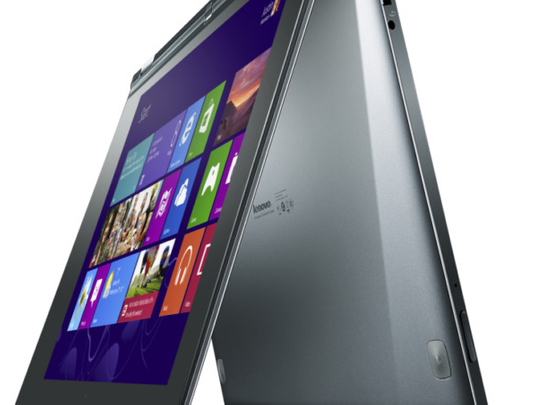
Fold, touch, type
Microsoft’s new Windows 8 OS can be used with both a touch screen or a keyboard, and the Yoga 13 offers both options. The 360-degree range of this ultrabook’s hinges means it can fold on itself completely to become a 13-inch tablet. The hinges are strong and have been bent 25,000 times in testing.
The Yoga becomes a tablet with its own stand if the keyboard is folded back underneath as a base and the screen is tilted, or if the device is stood up in an inverted V-shape, like a tent. The keyboard always disables itself once the screen is pushed past 190 degrees, but it is a little strange to hold the tablet and feel the exposed keys on the back. However, Lenovo does offer a cover that the keyboard can slide into.
A bug in tent mode meant the screen was presented upside down and a game appeared sideways. As a laptop, the Yoga has a smooth trackpad and Lenovo’s usual excellent keyboard, although it is not backlit. At 1.5kg, it is about 10 per cent heavier than a MacBook Air but has about 10 per cent more battery life at about eight hours. It is more than twice the weight of an iPad, so the stand position is definitely needed. The screen is vivid and very responsive.
At $1,000 (about Dh3,670)it is expensive as a tablet and well above a $700 mainstream laptop. But it is priced similarly to many Ultrabooks, with the bonus of its touchscreen and tablet capabilities. Available at shop.lenovo.com from Dh3,669 to Dh5,322.
Specs
Size: 333.4X224.8X16.9mm, 1.54kg
Display: 13.3 inches, 1600X900 pixels
Processor: 3rd generation Intel Core i7-3517U, i5-3317U, i3-3217U
Camera: 1.0MP 720p HD webcam
OS: Windows 8
Memory: 4GB, 8GB DDR3 RAM, 128GB solid state drive
— Financial Times
Note to self: Buy Note for self
I have been excited about the Note II for a while now and when I finally managed to get my hands on the device, it did not disappoint.
After trying my best to stay away from what I like to call ‘first-of-its-kind’ technology, the Note I, the Note II backed me up by proving that you should always wait an edition before committing to a new device.
When compared to the Note I, its screen is bigger, its processor is better, its memory is larger, its battery is stronger, the colours it comes in are cooler and best of all, tech journalists and reviewers are tired of calling it an abomination to smartphones and tablets alike.
Now retailing for as low as Dh2,399 for the LTE 16 GB version, it baffles me how this device can be compared to the iPhone 5. The phone, yes phone, retails for a fraction of the price of the iPhone 5 and comes packed with features that will not only help it walk right up to the pedestal the iPhone 5’s on but exchange a few choice words with the 4-inch device and it is left speechless.
When compared to the iPhone 5, the Samsung Galaxy Note II can hold up to 128GB of data (iPhone: 64GB) with a 1.6GHz quad-core processor (iPhone: 1.2 GHz dual-core processor) to ensure it runs smoothly.
The only problem with the device — as is the case with the Optimus Vu — is its size. The device takes up a lot of space, though users who use both tablets and smartphones on a regular basis will not complain and it won’t take long before you get used to it. Samsung Galaxy SIII users, for instance, won’t find it a problem at all.
The bigger screen is actually an advantage and the S pen is a gift from above. And with our telecom operators releasing more Android-friendly data plans, it will not be long before people make the permanent switch to Android-operated smartphones. And when they do, the Note II will be, without a doubt, a top contender.
Specs
Size: 80.5X151.1X9.4 mm, 180gm
Display: 5.5-inch HD Super AMOLED, 1280X720 pixels
Processor: 1.6 GHz quad-core processor
OS: Android 4.1 (Jelly Bean)
Camera: 8MP autofocus camera with LED Flash, 1.9MP VT Camera, BSI
Full HD 1080p Playback and Recording
Memory: 16/32/64GB user memory, 2GB RAM, micro SD slot for cards up to 64GB
— Gareth Kurt Warren/Features Writer
Size does matter
The LG Optimus Vu is the latest offering in the recently coined category of phablets. It combines the visual clarity of a tablet with the usefulness of a smartphone.
The first thing that strikes you about the Vu is its size. It’s big. Although it’s slim at 8.5mm, it engulfs the palm of your hand. For anyone fond of skinny jeans, I wouldn’t recommend the Vu. It is fine to hold for a call and does offer fantastic visuals. Reading, surfing the net and particularly skypeing are a breeze on the Vu. But in terms of speed of use, you’ll often need two hands to type and select apps. The on/off button too is awkwardly placed.
The Rubberdium pen, its stylus, can be frustrating. The Vu, annoyingly, doesn’t have in-built storage for the pen, and it can be easily mislaid. What’s more, when writing a note, its primary function, the phone’s sensitivity to your inscription is not great. If you brush the screen with your hand it will often register your hand over the rubber-tipped pen.
The Vu is a good-looking, if huge, phone. But it’s easy to see why it’s a cheaper alternative. It has a recommended price of Dh1,999.
Specs
Size: 139.6X90.4X8.5mm, 168gm
Display: 5 inches, 1024X768 pixels
Processor: 1.5GHz quad-core
OS: Android 4.0 (Ice Cream Sandwich)
Camera: 8MP autofocus camera with LED Flash, 1.3MP secondary camera
Memory: 32GB internal, 1GB DDR2 RAM
— Thomas Billinghurst/Features Writer











